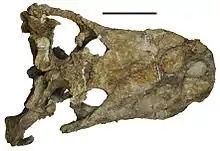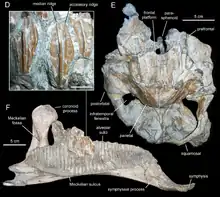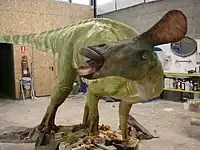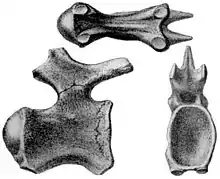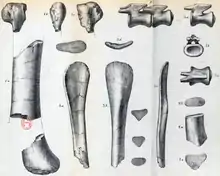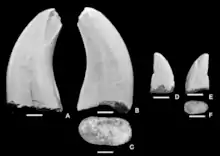| Tremp Formation | |
|---|---|
| Stratigraphic range: Maastrichtian-Thanetian ~ | |
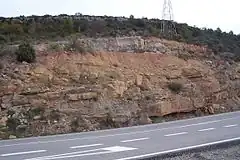 Outcrop of the Tremp Formation | |
| Type | Geological formation |
| Unit of | Tremp-Graus Basin |
| Sub-units | See text |
| Underlies | Àger Formation, Alveolina Limestone, alluvium |
| Overlies | Arén Formation |
| Area | ~325 km2 (125 sq mi)[1] |
| Thickness | 250–800 m (820–2,620 ft) |
| Lithology | |
| Primary | Sandstone, shale, conglomerate, limestone |
| Other | Marl, gypsum, siltstone, lignite |
| Location | |
| Coordinates | 42°06′35″N 01°04′22″E / 42.10972°N 1.07278°E |
| Region | Pre-Pyrenees, Catalonia |
| Country | |
| Extent | ~35 km (22 mi) |
| Type section | |
| Named for | Tremp |
| Named by | Mey et al. |
| Year defined | 1968 |
| Approximate paleocoordinates | 34°06′N 0°54′E / 34.1°N 0.9°E |
 Outline of the Tremp Formation in the Tremp Basin | |

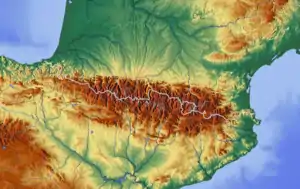
The Montsec is visible as an east–west running brown ridge
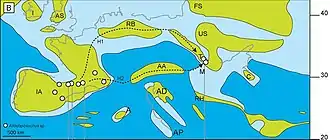

The Tremp Formation (Spanish: Formación de Tremp, Catalan: Formació de Tremp), alternatively described as Tremp Group (Spanish: Grupo Tremp), is a geological formation in the comarca Pallars Jussà, Lleida, Spain. The formation is restricted to the Tremp or Tremp-Graus Basin (Catalan: Conca de Tremp), a piggyback foreland basin in the Catalonian Pre-Pyrenees. The formation dates to the Maastrichtian to Thanetian,[2] thus the formation includes the Cretaceous-Paleogene boundary that has been well studied in the area, using paleomagnetism and carbon and oxygen isotopes. The formation comprises several lithologies, from sandstone, conglomerates and shales to marls, siltstones, limestones and lignite and gypsum beds and ranges between 250 and 800 metres (820 and 2,620 ft) in thickness. The Tremp Formation was deposited in a continental to marginally marine fluvial-lacustrine environment characterized by estuarine to deltaic settings.
The Tremp Basin evolved into a sedimentary depression with the break-up of Pangea and the spreading of the North American and Eurasian Plates in the Early Jurassic. Rifting between Africa and Europe in the Early Cretaceous created the isolated Iberian microplate, where the Tremp Basin was located in the northeastern corner in a back-arc basin tectonic regime. Between the middle Albian and early Cenomanian, a series of pull-apart basins developed, producing a local unconformity in the Tremp Basin. A first phase of tectonic compression commenced in the Cenomanian, lasting until the late Santonian, around 85 Ma, when Iberia started to rotate counterclockwise towards Europe, producing a series of piggyback basins in the southern Pre-Pyrenees. A more tectonically quiet posterior phase provided the Tremp Basin with a shallowing-upward sequence of marine carbonates until the moment of deposition of the Tremp Formation, in the lower section still marginally marine, but becoming more continental and lagoonal towards the top.
Shortly after deposition of the Tremp Formation, the Boixols Thrust, active to the north of the Tremp Basin and represented by the Sant Corneli anticline, started a phase of tectonic inversion, placing upper Santonian rocks on top of the northern Tremp Formation. The main phase of movement of another major thrust fault, the Montsec to the south of the Tremp Basin, happened not before the Early Eocene. Subsequently, the western Tremp Basin was covered by thick layers of conglomerates, creating a purely continental foreland basin, a trend observed going westward in the neighboring foreland basins of Ainsa and Jaca.
A rich and diverse assemblage of fossils has been reported from the formation, among which more than 1000 dinosaur bones, tracks dating up to just 300,000 years before the Cretaceous-Paleogene boundary, and many well-preserved eggs and nesting sites in situ, spread out over an area of 6,000 square metres (65,000 sq ft). Multiple specimens and newly described genera and species of crocodylians, mammals, turtles, lizards, amphibians and fish complete the rich vertebrate faunal assemblage of the Tremp Formation. Additionally, fresh-to-brackish water clams as Corbicula laletana, bivalves of Hippurites castroi, gastropods, plant remains and cyanobacteria as Girvanella were found in the Tremp Formation. The unique paleoenvironment, well-exposed geology, and importance as national heritage has sparked proposals to designate the Tremp Formation and its region as a protected geological site of interest since 2004, much like the Aliaga geological park and others in Spain.[3]
Due to the exposure, the interaction of tectonics and sedimentation and access, the formation is among the best studied stratigraphic units in Europe, with many universities performing geological fieldwork and professional geologists studying the different lithologies of the Tremp Formation. The abundant paleontological finds are displayed in the local natural science museums of Tremp and Isona, where educational programs have been established explaining the geology and paleobiology of the area. In 2016, the Tremp Basin and surrounding areas were filed to become a Global Geopark,[4] and on April 17, 2018, UNESCO accepted this proposal and designated the site Conca de Tremp-Montsec Global Geopark.[5] Spain hosts the second-most Global Geoparks in the world, after China.[6]
Etymology
The Tremp Formation was defined and named in 1968 by Mey et al., just as the Tremp Basin after the Pre-Pyrenean town of Tremp.[7] The various subdivisions of the formation or alternatively called group, are named after the villages, rivers, canyons and hills in the basin.[8][9]
Description

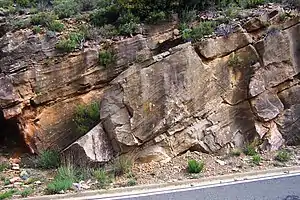
The Tremp Formation is a marginally marine to fluvial to lacustrine and continental sedimentary unit with a thickness varying between 250 and 800 metres (820 and 2,620 ft).[10] The formation is found in the Tremp-Graus Basin, a piggyback basin enclosed by the Sant Corneli anticline in the north, the Boixols Thrust in the northeast, the Montsec Thrust in the south and the Collegats Formation in the west.[11][12] The Tremp-Graus Basin is bordering the Ainsa Basin to the west, and the Àger Basin to the south.[13] The basin is subdivided into four synclinal areas, from east to west Vallcebre, Coll de Nargó, Tremp and Àger.[14] While in Benabarre, the Tremp Formation overlies the Arén Formation, in Fontllonga the formation rests on top of the Les Serres Limestone.[15] The formation is partly laterally equivalent with the Arén Formation.[16] The Tremp Formation is stratigraphically overlain by the late Paleogene, locally called Ilerdiense, Àger Formation and the Alveolina Limestone,[17] though in many parts of the Tremp Basin the formation is exposed and covered by alluvium.
The formation comprises several different lithologies, as sandstones, shales, limestones, marls, lignites, gypsum beds, conglomerates and siltstones have been registered.[12][18]
The start age of the Tremp Formation has been established on the basis of the presence of Abathomphalus mayaroensis, a planktonic foraminiferan indicative of the latest Maastrichtian age of the formation.[19] The lower section of the formation at the Elías site has been dated at 67.6 Ma,[20] while the top of the Tremp Formation, in the western portion of the basin overlain by the Alveolina Limestone,[21] named due to the abundance of Alveolina, is set at 56 Ma.[22]
On the northern side of the Axial Zone of the Pyrenees, in the French sub-Pyrenean zone and Aquitaine Platform of the foreland basin bordering the mountain range, the time-equivalent stratigraphic units of the Tremp Formation are the Mas d'Azil Formation and Marnes d'Auzas Formation for the latest Maastrichtian, the Entonnoir Formation for the Danian and the Rieubach Group correlating with the Thanetian portion of the Tremp Formation.[23]
Subdivisions
Studies performed in the 1990s described the Tremp Formation, also called Garumnian (Spanish: Garumniense de Tremp),[24][25] as a group with a subdivision into:[12]
Claret Formation
- Etymology - Claret
- Type section - along the road 1311[26]
- Thickness - up to 350 metres (1,150 ft)
- Lithologies - ochre to red shales, gypsum beds and intercalated sandstones and conglomerates
- Depositional environment - transitional marine to continental
- La Guixera Member
Esplugafreda Formation
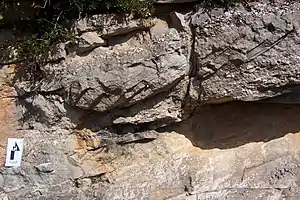
- Etymology - Esplugafreda canyon
- Type section - Barranco de Esplugafreda, in the valley of the Ribagorçana River east of Areny de Noguera[9]
- Thickness - 70 to 350 metres (230 to 1,150 ft)
- Lithologies - continental red beds; shales, sandstones and conglomerates
- Depositional environment - alluvial fans
Sant Salvador de Toló Formation
Talarn Formation

Conquès Formation
- Etymology - Conquès River
- Type section - Barranco de Basturs[8]
- Thickness - 60 to 500 metres (200 to 1,640 ft)
- Lithologies - greenish shales, sandstone lenses and conglomerates at the base
- Depositional environment - perilagoonal[note 1]
- Tossal d'Obà Member

- Etymology - Tossal d'Obà
- Type section - Tossal d'Obà Hill[8]
- Thickness - 7 metres (23 ft)
- Lithologies - micritic limestones and marls
- Depositional environment - distal fluvial to lagoonal-barrier island
- Basturs Member
- Etymology - Basturs
- Type section - Barranco de Basturs[8]
- Thickness - 2.5 to 80 metres (8.2 to 262.5 ft)
- Lithologies - micritic limestones, greenish shales and bioturbated fine sandstones
- Depositional environment - perilagoonal
Posa Formation

Alternative subdivisions
An alternative subdivision uses Grey Garumnian at the base, overlain by Lower Red Garumnian and Vallcebre Limestone at the top.[32] The Vallcebre limestone is laterally equivalent with another described unit, the Suterranya Limestone.[33] Pujalte and Schmitz in 2005 defined another member, the Claret Conglomerate, as representative of a conglomeratic bed inside the Claret Formation.[2]
In 2015, a new unit was allocated to the uppermost Cretaceous section of the Tremp Group, near the top of the Lower Red Garumnian. The 7 metres (23 ft) thick series of lithologically mature coarse-grained sandstones and microconglomerates rich in feldspars is positioned 7 to 10 metres (23 to 33 ft) below the Danian Vallcebre Limestone and was called the Reptile Sandstone.[34]
Tectonic evolution


drawing by Josep Anton Muñoz

drawing by Josep Anton Muñoz



The Tremp Basin was formed in the northeastern corner of the Iberian Plate, a microplate that existed as a separate tectonic block between the Eurasian and African Plates since the Hercynian orogeny that formed the supercontinent Pangea. Progressive opening of the Atlantic Ocean between the Americas and at first Africa, later Iberia and finally Europe, caused large differential motions between these continents,[35] with extensional tectonics starting in the Early Jurassic with the opening of the Neotethys ocean between southwestern Europe and Africa.[36] During this period, evaporites were deposited in the rift basins,[37] later in the tectonic history becoming important décollement surfaces for the compressional movements.[38] The phase of extension continued into the Early Cretaceous when the Iberian Plate started to move counterclockwise to converge with the Eurasian Plate.[39]
Back-arc basin
Approximately from the late Berriasian to late Albian (120 to 100 Ma), the Iberian Plate was an isolated island, separated from current southern France by a mostly shallow sea with a deeper pelagic channel in between the southwestern Eurasian and northeastern Iberian coasts. The present-day area of the Pyrenees with an area of 1,964 square kilometres (758 sq mi) in those times was much larger due to the various episodes of compressional tectonic forces and resulting shortening afterwards. The Tremp Basin, alternatively called Organyà Basin, was the depocenter of sedimentation during the late Early Cretaceous, showing an estimated vertical sedimentary thickness of 4,650 metres (15,260 ft) comprising mostly hemipelagic marls and limestones,[40] deposited in a back-arc basin setting with normal faults parallel to the Pyrenean axis,[41] and cross-cut by transverse faults, separating the various west-to-east minibasins. These minibasins showed a deepening trend from the Gulf of Biscay to the Mediterranean.[36][42][43]
At the end of formation of the back-arc basin, around 95 Ma, high temperature metamorphism developed as a result of crustal thinning synchronously or immediately after the Albian to Cenomanian basin formation. Lower crustal granulitic rocks, as well as ultramafic upper mantle rocks (lherzolites) were emplaced along the prominent North Pyrenean Fault (NPF) crustal feature. The North Pyrenean Fault developed during the sinistral (left-lateral) displacement of the Iberian Plate, which age is determined by the age of flysch pull-apart basins formed synchronously with the strike-slip movement along the NPF from Middle Albian to Early Cenomanian.[44] This period is characterized by a local unconformity in the Tremp Basin,[45] while this is not registered farther to the west of the Pre-Pyrenean minibasins near Pont de Suert.[46]
Tectonic inversion
The previous phase was followed by a tectonically more quiet setting in the basins surrounding the slowly rising Pyrenees. Research published in 2014 has revealed a renewed phase of evaporitic deposition from the Coniacian to Santonian in the Cotiella Basin, west of the Tremp Basin.[47] The relative tectonic quiescence lasted until the late Santonian, approximately around 85 Ma,[36][42] with other authors defining this moment at 83 Ma.[48] At this time, continental subduction and back-arc basin inversion commenced,[36] with the remainder of the Neotethys Ocean progressively disappearing. During this phase, sea floor spreading in the Bay of Biscay occurred, leading to a rotation of plate movements, observed more prominently in the eastern part of the Iberian Plate, where convergence rates of 70 kilometres (43 mi) per million years have been noted.[49] As is common in inverted tectonic regimes, the normal faults of the early Mesozoic were reactivated into reverse faults at the end of the Cretaceous and continuing into the Paleogene.[42] The lithospheric subduction has not been interpreted from seismic reflection data, with the ECORS profile obtained in the late 1980s as primary example,[50] due to the large thickness and poor seismic resolution, but later analysis using tomography has identified this feature below the Pre-Pyrenean chain.[51] The presence of lithospheric subduction is a common feature in other Alpine orogenic chains as the Alps and Himalayas.[52]
Piggyback basin
From the late Santonian to the late Maastrichtian,[53] on the different thrust sheets of the southward compressional Pre-Pyrenees, a series of piggyback basins were formed,[54] one of which was the Tremp Basin.[55] The bathymetry of these basins show a general deepening towards the west, with major turbidite deposition in the Ainsa Basin and farther west.[53] Subsequent ongoing inversion of the basins show a similar trend, with compressional phases becoming younger from east to west. While the onlap and erosion in the Clamosa area started in the early Eocene, around 49 Ma, the western portion experienced this phase terminating around the end of the Eocene, approximately at 35 Ma.[56] In the Jaca Basin, to the west of the Ainsa and Tremp Basins, during the Middle Eocene, flysch was deposited in an underfilled basin setting,[57] while in the western Tremp Basin thick conglomerates, known as the Collegats Formation, were deposited, sourced by the various thrust sheets in the hinterland.[58]
Boixols and Montsec thrusting
The Boixols–Cotiella thrust sheet was emplaced since the Late Cretaceous, placing late Santonian rocks on top of the northernmost Tremp Formation, found in the subsurface underneath the Sant Corneli anticline. This was followed by the tectonic movement of the Montsec–Peña Montañesa thrust sheet during the Early Eocene and the western Sierras Exteriores thrust sheet from the Mid-Eocene to Early Miocene.[59] The dating of the Montsec Thrust has been established on the basis of the stratigraphies of the overlying hanging wall (Triassic to Cretaceous) onto the Lutetian (locally called Cuisian) fluvial sediments of the Àger Basin to the south of the Montsec.[60][61] These tectonic movements are indicative of the main uplift phase of the Pyrenees.[36]
Salt tectonics
The involvement of evaporites as décollement surfaces in compressional tectonic regimes is a widespread phenomenon on Earth. The evaporites, mainly salt but also gypsum, function as mobile ductile surfaces along which thrust faults can move. Global examples of halokinesis in compressional inverted tectonic regimes include the south Viking Graben, and Central Graben in the North Sea,[62] offshore Tunisia,[63] the Zagros mountains of Iraq and Iran,[64][65] northern Carpathians in Poland,[66] western,[67] and eastern Colombian, along the Eastern Frontal Fault System of the Eastern Ranges of the Andes,[68] the Al Hajar Mountains of Oman,[69] Dnieper-Donets Basin in the Ukraine,[70] the Sivas Basin in Turkey,[71] the Kohat-Potwar fold and thrust belt of Pakistan,[72] the Flinders Ranges in South Australia,[73] during the Eurekan orogeny in the Sverdrup Basin of northeastern Canada and western Greenland,[74] and many more.[75]
In the western Cotiella Basin, salt inflation and withdrawal played a major role in the differential sedimentary thicknesses, facies changes and tectonic movements.[76]
Eocene to recent
After the Middle Eocene, thick conglomerates were deposited in the western Tremp Basin and the thrust sheets reached their maximum displacement, this led to a shift of the depocenter from the Pre-Pyrenees towards the Ebro Basin.[77] Paleomagnetic data show that the Iberian Plate went through another phase of counterclockwise rotation, though not as fast as in the Santonian. Between 25 and 20 Ma, in the late Oligocene and early Miocene, a rotation of 7 degrees has been noted.[78] This phase of rotation correlated with the thrusting in the westernmost areas of the southern Pre-Pyrenees, the Sierras Marginales, leading to continental conditions in that area from the early Miocene (Burdigalian) onwards.[79]
Depositional history
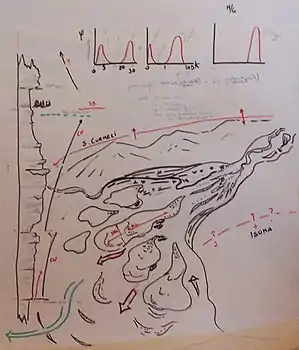
The depositional environment of the Tremp Formation varies between continental, lacustrine, fluvial, and marginally marine (estuarine to deltaic and coastal). The continental deposits in the east of the basin have been interpreted as the distal part of alluvial fans, while the presence of cyanobacteria Girvanella in the lacustrine limestones indicates variability in salinity in the lacustrine areas and a possible lateral relation with transitional environments. The presence of great quantities of the fungus Microcodium indicates traces of rootlets.[18] The biochemical data, based on C and O isotope analysis could indicate a rise in temperature, an increase in evaporation and a higher production of plant material at the transition of Maastrichtian and Paleocene.[80] The top of the Tremp Formation is close to the Paleocene–Eocene Thermal Maximum, which could explain the relative lack of diversity in mammal genera.[81]
Four phases in the depositional history of the Tremp Formation are noted:[82]
- Formation of an estuarine regime near the end of a Cretaceous regression in the Pyrenean basins, characterized by coastal plains where thick clays were deposited, cut by sporadic fluvial channels. At the margins of the basin, swampy conditions existed with sedimentation of carbonates. In these zones, the last dinosaurs inhabiting the area before the Cretaceous-Paleogene boundary left their marks in tracks, eggs and bones. These areas were accompanied by marshes, as evidenced by the many plant remains that produced the lignite deposits found in the lower part of the Tremp Formation. During this first phase in the sedimentary sequence of the formation, the Montsec was already a slightly elevated area in the south and along the submerged slopes of that hill, lacustrine limestones were deposited.
- At the end of the Cretaceous, a geologically sudden drop of sea level happened, giving rise to a wide fluvial-dominated basin. In this environment, river channels deposited sandstones and abundant overbank clays with numerous paleosols in the basin. On the southern side of the rising Montsec, the Àger Basin, a similar fluvial system developed with a far more coarse-grained sandy character than in its northern counterpart around Tremp. The paleocurrents in the Àger Basin were towards the north and northwest.[83] The enclosed continental basin turned into a more coastal environment at a transgressional phase with smaller channels where oncolites were laid down. The river systems on both sides of the Montsec were sourced by the easternmost parts of the present Pyrenees, with the Empordà High as provenance area. This east-to-west fluvial system, contrary to the present-day west–east flowing direction of the Ebro Basin, persisted until the Late Eocene. The uppermost unit of the Maastrichtian sequence, the coarse-grained Reptile Sandstone, has been interpreted as a fast-flowing braided river channel.[34]
- The start of the Paleocene was marked by a more tranquil deposition of lacustrine character. It has been hypothesized that the Alpine orogeny during this phase was less active and/or a regional rise in sea level allowed the basin to be flooded. During this phase, the limestones of Vallcebre and its lateral equivalents were deposited in the lake.
- A renewed phase of tectonic activity reactivated the fluvial to alluvial sedimentation, with abundant conglomerates and conglomeratic sandstones as a result. The provenance area for these uppermost sections of the Tremp Formation were first interpreted as the presently high mountains of the Axial Zone of the Pyrenees, at that time a forming orogen. Detailed provenance analysis published in 2015 by Gómez et al. however shows that the Àger basin was fed from the south (Prades area) and the Cadí-Vallcebre area was fed from the southeast (Montseny area), both areas belonging to the Ebro Massif. The Pyrenean basement (Axial Zone) was not a source area during the sedimentation of the Tremp Formation.[84] The latest phase of depositional evolution is noted in a wider area in the Pre-Pyrenees and to the south in the Ebro Basin, that began its formation during the Eocene, building up to its present shape in Oligocene and Miocene times.
Cretaceous-Paleogene boundary
The Tremp Formation spans the latest stage of the Cretaceous (Maastrichtian) and the earliest stages of the Paleocene (Danian and Thanetian). This has made the formation one of a few European unique localities to study the K/T boundary. In the Tremp Basin, the boundary is registered at Coll de Nargó, Isona and Fontllonga and established on the basis of paleomagnetism and a strong decrease of ∂13C and ∂18O isotopes.[85] The typical iridium layer, found in other sites where the Cretaceous-Paleogene boundary has been noted, as Gubbio in Italy and Caravaca in Spain,[86] has not been registered in the Tremp Formation.[87]
Paleontology

The Tremp Formation provided many fossilized dinosaur eggs.[88] The dinosaur eggs of Basturs are contained in the formation bordering the Arén Formation and the area where eggs are found stretches out for 6,000 square metres (65,000 sq ft). A great number of nests are visible as well as numerous fragments of egg shells. The presence of wave ripples indicates a beach-like environment where dinosaurs laid their eggs for a long time. The eggs are subcircular with diameters of approximately 20 centimetres (7.9 in) and egg shell thicknesses between 1.5 and 2 millimetres (0.059 and 0.079 in). Many eggs are found in groups of between four and seven gatherings, indicating the in situ preservation of the nests.[89]
Also, remains of several genera of dinosaurs are described from the Tremp Formation.[90] The Tremp and underlying Arén Formations are the richest sites for dinosaur fossils in the Pyrenees,[19] with only at Basturs more than 1000 bone fragments found.[91] The dinosaur paleofauna has been compared to Hațeg in Romania, famous for the pterodactyl Hatzegopteryx named after the location.[92] Furthermore, a rich variety of other reptiles, among which the new species and youngest fossil record of the Cretaceous turtle Polysternon; Polysternon isonae,[93] as well as amphibians, lizards, fish,[94] and mammals,[95] for example the earliest Paleocene multituberculate Hainina pyrenaica,[96] have been registered, showing a unique faunal assemblage for the Cretaceous-Paleogene boundary, not found elsewhere in Europe.[81]
The holes found on the dip slope at Ermita La Posa were initially interpreted as tracks produced by sauropod dinosaurs. Later investigations and interpretations of the depositional environment of the Maastrichtian; the coastal origin of the trackbed with plenty of marine invertebrates, have led researchers to interpret part of the ichnofossils as feeding traces of rays in the intertidal zones. During their feeding activity, the rays produce holes in the top sedimentary layers, when they feed on marine invertebrates buried in the top sediment.[91]
The Reptile Sandstone, when identified as a separate unit, was called as such because of the great abundance of fossil chelonid turtles,[97] Bothremydidae, crocodile teeth, theropod limbs,[98] and hadrosaur femurs.[99]
Sauropod nesting sites

A detailed analysis of the nesting sites of Coll de Nargó, at the Pinyes locality, has been performed in 2010 by Vilat et al. The eggs were found in the lower portion of the Lower Red Garumnian, with local facies comprising calcareous silty mudstones, very fine to fine-grained sand bodies, and medium to coarse-grained sandstones. The rocks, in a 36 metres (118 ft) thick interval,[100] are interpreted as sedimentary deposits of a fluvial environment located some distance away from an active stream channel.[101]
Most eggs exposed at the Pinyes locality were incompletely preserved because of recent erosion; however, excavation occasionally revealed relatively intact specimens in the subsurface. Some eggs exposed in cross-section revealed numerous eggshell fragments, predominantly oriented concave up within the mudstone matrix that filled the egg interior. Analysis of the eggshells at Pinyes provided a range of 2.23 to 2.91 millimetres (0.088 to 0.115 in) in shell thickness, with a mean range of 2.40 to 2.67 millimetres (0.094 to 0.105 in). Radial thin sections and SEM images of the eggshells showed a single structural layer of calcite. The eggshell surfaces displayed abundant elliptical pore openings that varied from 65 to 120 microns in width.[100]

The mudstones surrounding the eggs displayed extensive bioturbation, minor faults, and penetrative foliation with a northeast–southwest orientation. Eggshell fragments were often displaced and overlap one another, and the eggs exhibited significant deformation due to compression. Most eggs mapped in the field showed a long axis direction 044, thus having a general northeast–southwest orientation, which coincides with regional stress fields resulting from tectonic compression.[102]
The eggs, in clusters or "clutches" of up to 28 individual eggs, were described as Megaloolithus siruguei, an oospecies well documented from various localities in northern Catalonia and southern France. The description was done on the basis of egg size, shape, eggshell microstructure, tuberculate ornamentation, and the presence of transversal canals in a tubocanaliculate pore system, an unequivocal feature of this oospecies. The egg horizons within the Tremp Formation were continuous before the tectonic inversion phase of the basin. The compressional tectonic regime produced structural deformation of the egg-bearing strata. The dip of the beds in the mountainous region can contribute to misinterpretation of reproductive behavior, hence the analysis of the eggs in combination with tectonic stresses gives a more complete picture of the shapes of the eggs.[103]

An interpretation of the nest excavation at Pinyes was made and compared to other nesting sites of sauropods found all over the world, in particular in the Aix Basin of southern France, the Allen and Anacleto Formations of Argentina, and the Lameta Formation of India. The nest sizes and shapes of Pinyes show great similarities with the other analyzed sites.[104] Research conducted in 2015 by Hechenleitner et al. include a comparison with the Cretaceous Sanpetru Formation of Hațeg paleo-island in Romania, the Los Llanos Formation at Sanagasta geological park in Argentina, and the Boseong Formation of the Gyeongsang Basin in South Korea.[105]
A common nest size of 25 eggs has been suggested for the Pinyes locality. Small egg clusters that display linear or grouped egg arrangements reported at Pinyes and other localities likely reflect recent erosion. The distinct clutch geometry reported at Pinyes and other megaloolithid localities worldwide, strongly suggests a common reproductive behavior that resulted from the use of the hind foot for scratch-digging during nest excavation.[106] Due to their size and weight, the titanosaurs could not heat the eggs by direct body contact, so must have relied on external environmental heat for incubating their eggs.[107] However, modern megapode birds as the maleo (Macrocephalon maleo), the Moluccan megapode (Eulipoa wallacei) and scrubfowls (Megapodius spp.) in Southeast Asia and Australia, burrow their eggs using the heat in the top soil to incubate them and provide protection from predators.[108] The egg spatial distribution, in small clusters linearly to compactly grouped, but contained in round shaped areas of up to 2.3 metres (7.5 ft) would either support burrow- or mound-nesting at Pinyes.[109]
Hadrosaur ichnofossils
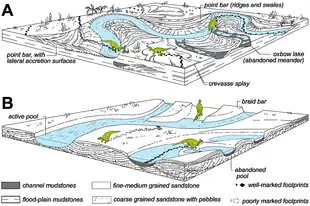
Over 45 fossil localities yielded hadrosaurid fossils in the Lower Red Garumnian of the eastern Tremp Syncline.[16] Various new specimens of indeterminate Lambeosaurinae were described in 2013 by Prieto Márquez et al.[110] Furthermore, many hadrosaur ichnofossils have been found in the Tremp Formation and were analyzed in great detail by Vila et al. in 2013. The most abundant track types in fluvial settings are the pedal prints of hadrosaurs, while titanosaur ichnofossils and a single theropod track were found in lagoonal environments.[111] The authors concluded:[112]
- The fluvial lower red unit of the Tremp Formation exhibits meandering and braided fluvial systems with favorable conditions for track production and preservation, like those of North America and Asia.
- The dinosaurs mainly produced the tracks on the floodplain, within the channels, and on and within crevasse splay deposits in low water stage conditions, and the footprints were infilled by sands during high water stage (stream reactivation).
- The track record is composed of abundant hadrosaur and scarce sauropod and theropod tracks. The hadrosaur tracks are significantly smaller in size but morphologically similar to comparable records in North America and Asia. They are attributable to the ichnogenus Hadrosauropodus.
- A rich track succession composed of more than 40 distinct track levels indicates that hadrosaur footprints are found above the early Maastrichtian–late Maastrichtian boundary and most noticeably in the late Maastrichtian, with tracks occurring abundantly in the Mesozoic part of the C29r magnetochron, during the last 300,000 years of the Cretaceous.
- The occurrence of hadrosaur tracks in the Ibero-Armorican island seems to be characteristic of the late Maastrichtian time interval and thus they are important biochronostratigraphic markers in the faunal successions of the Late Cretaceous in southwestern Europe.
Fossil content
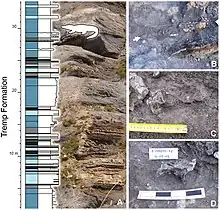



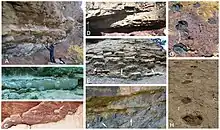
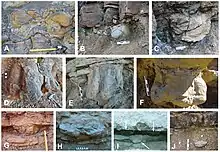
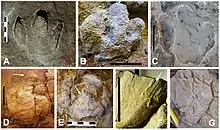
A-F - hadrosaur tracks
G - sauropod track


- Pollen
Additionally, many pollen have been described from the Tremp Formation, east of Isona and 22 kilometres (14 mi) east of Tremp:[174]
- Polypodiaceoisporites gracicingulis, P. maximus, P. tatabanyensis, P. vitiosus
- Leiotriletes adriennis, L. dorogensis, L. microadriennis
- Cycadopites kyushuensis, C. minar
- Monocolpopollenites dorogensis, M. tranquillus
- Semioculopollis croxtonae, S. praedicatus
- Cicatricosisporites cf. triangulus
- Cupressacites insulipapillatus
- Cupuliferoipollenites pusillus
- Cyrillaceaepollenites barghoorniacus
- Granulatisporites palaeogenicus
- Inaperturopollenites giganteus
- Labraferoidaepollenites menatensis
- Laevigatosporites haardti
- Minorpollis hojstrupensis
- Nudopollis minutus
- Oculopollis cf. minoris
- Pityosporites insignis
- Plicapollis serta
- Punctatisporites luteticus
- Retitricolporites andreanszkyi
- Rugulitriporites pflugi
- Subtriporopollenites constans
- Suemigipollis cf. triangulus
- Tetracolporopollenites halimbaense
- Trilobosporites (Tuberosisporites)
- Vacuopollis cf. concavux
- Granomonocolpites
- Patellasporites
- Platycaryapollenites
- Polyporites
- Retimonocolpites
Research and exhibitions
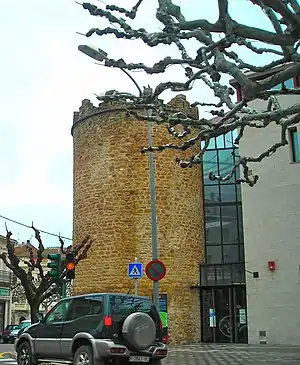
Every year, over 800 geologists visit El Pallars Jussà and more than 1500 university students from all over Europe come to the Tremp-Graus Basin to carry out their geological fieldwork. The basin is also regarded by petroleum companies as a perfect place to study the interplay of tectonic movements with the different types of lithologies. The Museu Comarcal de Ciències Naturals ("Local District Natural Science Museum") in Tremp, built attached to the Torre de Soldevila in the center of town, is a popular destination for school visits. It houses a permanent fossil exhibition with a wide variety of remains, ranging from dinosaurs to fossilized invertebrates such as corals, bivalves, gastropods, and more.[175]
The Museu de la Conca Dellà of Isona houses replicas of bone remains, restorations of dinosaurs and an authentic nest of eggs,[176] left behind by the last dinosaurs to have lived in the valley during the Cretaceous period. The museum also contains numerous other archaeological remains from the Roman settlement of Isona. In recent years, the Consell Comarcal (Regional Council) has promoted several new initiatives, including the creation of a geological program especially adapted to local schools and a series of guided visits to the main archaeological sites of the region.[177]
The unique paleoenvironment, well-exposed geology, and importance as national heritage have sparked proposals to designate the Tremp Formation and its region as a protected geological site of interest, much like the Aliaga geological park and others in Spain.[3] After having been filed as a candidate since 2016, the Tremp Basin and surrounding areas as El Pallars Jussà, Baix Pallars to Pallars Sobirà, Coll de Nargó to l'Alt Urgell, Vilanova de Meià, Camarasa and Àger to the Noguera were included as a UNESCO Global Geopark,[4] and included in the Global Geoparks Network.[178] On April 17, 2018, UNESCO accepted the proposal and designated the site as Conca de Tremp-Montsec Global Geopark, stating:[5]
"This area is internationally recognized as a natural laboratory for sedimentology, tectonics, external geodynamics, palaeontology, ore deposits and pedology. In addition, other natural and cultural heritage is also remarkable including astronomy and archaeological sites."
Panoramas
See also
- List of dinosaur-bearing rock formations
- List of Vertebrate fauna of the Maastrichtian stage
- Timeline of Cretaceous–Paleogene extinction event research
- Climate across Cretaceous–Paleogene boundary
- Geology of the Pyrenees
- Hell Creek Formation - Cretaceous-Paleogene contemporaneous fossiliferous formation of the United States
- Cerrejón Formation - Paleocene contemporaneous fossiliferous formation of Colombia
Notes and references
Notes
- ↑ Other authors consider the Conquès Formation a lateral equivalent of the lower red unit of the Tremp Formation[29]
- ↑ Considered synonymous with Pararhabdodon according to Fossilworks[133]
References
- ↑ Area Calculator Google Maps
- 1 2 Pujalte & Schmitz, 2005, p.82
- 1 2 Bosch Lacalle, 2004, p.40
- 1 2 Geoparc Mundial de la UNESCO Conca de Tremp-Montsec
- 1 2 Conca de Tremp-Montsec Global Geopark - UNESCO.org
- ↑ Global Geoparks Network - Members list
- ↑ Rosell et al., 2013, p.19
- 1 2 3 4 Cuevas, 1992, p.100
- 1 2 3 Cuevas, 1992, p.102
- ↑ Arribas et al., 1996, p.11
- ↑ Bosch Lacalle, 2004, p.18
- 1 2 3 Cuevas, 1992, p.96
- ↑ Bosch Lacalle, 2004, p.23
- ↑ Blanco et al., 2014, p.3
- ↑ López Martínez et al., 1996, p.63
- 1 2 Prieto Márquez et al., 2013, p.2
- ↑ De Renzi, 1996, p.205
- 1 2 Arribas et al., 1996, p.17
- 1 2 Canudo et al., 2000, p.340
- ↑ Puértolas et al., 2011, p.2
- ↑ Serra Kiel et al., 1994, p.276
- ↑ Barnolas & Gil Peña, 2001, p.24
- ↑ Ford et al., 1967, p.434
- ↑ Cuevas, 1992, p.97
- ↑ Arribas et al., 1996, p.10
- 1 2 Cuevas, 1992, p.103
- ↑ Cuevas, 1992, p.106
- ↑ Cuevas, 1992, p.101
- ↑ Puértolas et al., 2010, p.73
- ↑ Museu de la Conca Dellà - La Posa
- ↑ Cuevas, 1992, p.99
- ↑ Bravo et al., 2005, p.51
- ↑ Díez Canseco, 2016, p.53
- 1 2 Blanco et al., 2015b, p.148
- ↑ Andeweg, 2002, Ch.1 p.1
- 1 2 3 4 5 Sibuet et al., 2004, p.3
- ↑ García Senz, 2002, p.264
- ↑ López Mir et al., 2014, p.15
- ↑ Rushlow et al., 2013, p.844
- ↑ García Senz, 2002, p.7
- ↑ García Senz, 2002, p.257
- 1 2 3 Sibuet et al., 2004, p.14
- ↑ García Senz, 2002, p.31
- ↑ Muñoz, 1992, p.238
- ↑ García Senz, 2002, p.105
- ↑ García Senz, 2002, p.201
- ↑ López Mir et al., 2014, p.14
- ↑ Rosenbaum et al., 2002, p.124
- ↑ Rosenbaum et al., 2002, p.122
- ↑ Dinarès Turell et al, 1992, p.265
- ↑ Sibuet et al., 2004, p.12
- ↑ Muñoz, 1992, p.244
- 1 2 García Senz, 2002, p.285
- ↑ Muñoz, 1992, p.241
- ↑ Dinarès Turell et al, 1992, p.267
- ↑ Barnolas & Gil Peña, 2001, p.31
- ↑ Teixell et al., 2016, p.262
- ↑ Nijman, 1998, p.140
- ↑ Fernández et al., 2012, p.545
- ↑ Teixell & Muñoz, 2000, p.257
- ↑ Fernández et al., 2012, p.548
- ↑ Ten Veen et al., 2012, p.460
- ↑ Jaillard et al., 2017, p.232
- ↑ Khadivi, 2010, p.56
- ↑ Muñoz et al., 2017, p.16
- ↑ Krzywiec & Sergés, 2006, p.81
- ↑ FGarcía & Jiménez, 2016, p.31
- ↑ Parravano et al., 2015, p.25
- ↑ Claringbould et al., 2011, p.1
- ↑ Brown et al., 2010, p.80
- ↑ Legeay et al., 2017, p.20
- ↑ Ghani et al., 2017, p.38
- ↑ Backé et al., 2010, p.59
- ↑ López Mir et al., 2017, p.110
- ↑ Salt Basins - Carlos Cramez - Universidade Fernando Pessoa
- ↑ López Mir et al., 2014, p.12
- ↑ Nijman, 1998, p.138
- ↑ Rosenbaum et al., 2002, p.121
- ↑ Millán Garrido et al., 2000, p.294
- ↑ López Martínez et al., 1996, p.65
- 1 2 López Martínez & Peláez Campomanes, 1999, p.694
- ↑ Rosell et al., 2001, pp.54-55
- ↑ Gómez, 2015, p.9
- ↑ Gómez et al., 2015, p.12
- ↑ López Martínez et al., 1996, p.64
- ↑ Meléndez & Molina, 2008, p.108
- ↑ Meléndez & Molina, 2008, pp.112-113
- ↑ Hundreds of dinosaur eggs found in Spain - Inquisitr.com
- ↑ Bosch Lacalle, 2004, p.44
- ↑ Weishampel et al., 2004, pp.588-593
- 1 2 Paleontology - Parc Cretaci - Museu de la Conca Dellà
- ↑ Canudo et al., 2000, p.341
- ↑ Marmi et al., 2012, p.133
- ↑ López Martínez et al., 2001, p.53
- 1 2 3 4 5 6 7 8 9 López Martínez & Peláez Campomanes, 1999, p.686
- 1 2 Peláez Campomanes et al., 2000, p.702
- 1 2 Blanco et al., 2015, p.149
- 1 2 3 4 Blanco et al., 2015, p.152
- 1 2 Blanco et al., 2015, p.154
- 1 2 Vilat et al., 2010, p.3
- ↑ Vilat et al., 2010, p.2
- ↑ Vilat et al., 2010, p.4
- ↑ Vilat et al., 2010, p.7
- ↑ Vilat et al., 2010, p.11
- ↑ Hechenleitner et al., 2015, p.6
- ↑ Vilat et al., 2010, p.12
- ↑ Hechenleitner et al., 2015, p.16
- ↑ Hechenleitner et al., 2015, p.17
- ↑ Hechenleitner et al., 2015, p.19
- ↑ Prieto Márquez et al., 2013, pp.22-34
- ↑ Vila et al., 2013, p.5
- ↑ Vila et al., 2013, pp.12-14
- 1 2 3 4 5 6 7 Claret 4 at Fossilworks.org
- 1 2 Claret 0 at Fossilworks.org
- ↑ Casa Fabà at Fossilworks.org
- ↑ Blanco et al., 2015a, p.10
- 1 2 Fumanya Sud at Fossilworks.org
- ↑ Blanco et al., 2014, p.7
- 1 2 3 4 5 6 7 8 9 10 11 12 13 14 15 16 17 18 Els Nerets at Fossilworks.org
- ↑ Amor-3 at Fossilworks.org
- ↑ Puértolas et al., 2014, p.4
- ↑ Elías site at Fossilworks.org
- 1 2 3 4 5 6 7 8 9 10 11 12 13 14 15 16 17 18 19 20 21 Blasi 2 at Fossilworks.org
- 1 2 3 4 5 Sant Esteve de la Sarga, Moró at Fossilworks.org
- 1 2 3 Suterranya mine at Fossilworks.org
- 1 2 Barranc de Torrebilles-1 at Fossilworks.org
- 1 2 3 4 Mina Esquirol-1 at Fossilworks.org
- ↑ Prieto-Márquez, A.; Sellés, A. (2023). "Evolutionary convergence in a small cursorial styracosternan ornithopod dinosaur from western Europe". Journal of Vertebrate Paleontology. 42 (5). e2210632. doi:10.1080/02724634.2023.2210632. S2CID 259335419.
- ↑ Prieto Márquez et al., 2019
- ↑ Puértolas et al., 2011, p.3
- 1 2 3 Le Loeuff, 2012, p.551
- ↑ Puértolas et al., 2010, p.71
- ↑ Pararhabdodon at Fossilworks.org
- ↑ Les Llaus at Fossilworks.org
- ↑ Párraga & Prieto Márquez, 2019
- ↑ Vila, Bernat; Sellés, Albert; Moreno-Azanza, Miguel; Razzolini, Novella L.; Gil-Delgado, Alejandro; Canudo, José Ignacio; Galobart, Àngel (2022-02-07). "A titanosaurian sauropod with Gondwanan affinities in the latest Cretaceous of Europe". Nature Ecology & Evolution. 6 (3): 288–296. doi:10.1038/s41559-021-01651-5. ISSN 2397-334X. PMID 35132183. S2CID 246650381.
- ↑ Norets at Fossilworks.org
- 1 2 Ullastre & Masriera, 1998, p.115
- 1 2 3 Mina Esquirol-2 at Fossilworks.org
- ↑ Costa de Castelltallat at Fossilworks.org
- ↑ Sellés, A. G.; Vila, B.; Brusatte, S. L.; Currie, P. J.; Galobart, À. (2021). "A fast-growing basal troodontid (Dinosauria: Theropoda) from the latest Cretaceous of Europe". Scientific Reports. 11 (1): Article number 4855. Bibcode:2021NatSR..11.4855S. doi:10.1038/s41598-021-83745-5. PMC 7921422. PMID 33649418.
- ↑ Csiki-Sava, Zoltán; Buffetaut, Eric; Ősi, Attila; Pereda-Suberbiola, Xabier; Brusatte, Stephen L. (2015-01-08). "Island life in the Cretaceous - faunal composition, biogeography, evolution, and extinction of land-living vertebrates on the Late Cretaceous European archipelago". ZooKeys (469): 1–161. doi:10.3897/zookeys.469.8439. ISSN 1313-2989. PMC 4296572. PMID 25610343.
- 1 2 3 4 5 6 Coll de Nargó at Fossilworks.org
- ↑ Orcau-1 at Fossilworks.org
- 1 2 Els Terrers at Fossilworks.org
- ↑ Serrat de Pelleu at Fossilworks.org
- ↑ Bravo et al., 2005, p.55
- ↑ Costa de la Coma at Fossilworks.org
- ↑ Biscarri, Isona at Fossilworks.org
- ↑ Bravo et al., 2005, p.54
- ↑ Els Terrers 2 at Fossilworks.org
- 1 2 Orcau-2 tracksite at Fossilworks.org
- ↑ Torrent de Guixers tracksite at Fossilworks.org
- ↑ Cingles del Boixader at Fossilworks.org
- ↑ Díez Canseco, 2016, p.75
- ↑ Orcau 2 at Fossilworks.org
- ↑ Suterranya-1 at Fossilworks.org
- 1 2 St. Corneli at Fossilworks.org
- 1 2 Kedves et al., 1985, p.249
- ↑ Ullastre & Masriera, 1998, p.101
- ↑ Marmi, 2016, p.88
- ↑ Marmi, 2016, p.63
- ↑ Marmi, 2016, p.71
- ↑ Marmi, 2016, p.74
- ↑ Marmi, 2016, p.69
- ↑ Marmi, 2016, p.96
- ↑ Marmi, 2016, p.78
- ↑ Marmi, 2016, p.90
- ↑ Marmi, 2016, p.59
- ↑ Marmi, 2016, p.85
- ↑ Marmi, 2016, p.66
- ↑ Blanco et al., 2015a, p.30
- 1 2 Arribas et al., 1996, p.12
- ↑ Kedves et al., 1985, pp.249-250
- ↑ Museu Comarcal de Ciències Naturals de Tremp
- ↑ Parc Cretaci - Museu de la Conca Dellà
- ↑ El Pallars Jussà, a geological paradise
- ↑ Global Geoparks UNESCO conference
Bibliography
Regional geology
- Andeweg, Bernd. 2002. Cenozoic tectonic evolution of the Iberian Peninsula, causes and effects of changing stress fields (PhD thesis), 1–192. Vrije Universiteit Amsterdam. Accessed 2018-05-24.
- Barnolas, A., and I. Gil-Peña. 2001. Ejemplos de relleno sedimentario multiepisódico en una cuenca de antepaís fragmentada: La Cuenca Surpirenaica. Boletín Geológico y Minero 112. 17–38. Accessed 2018-05-24. (in Spanish)
- Dinarès Turell, Jaume; Elizabeth McClelland, and P. Santanach. 1992. Contrasting rotations within thrust sheets and kinematics of thrust tectonics as derived from palaeomagnetic data: an example from the Southern Pyrenees, 265–275. Thrust Tectonics, Springer, Dordrecht. Accessed 2018-05-24.
- Fernández, O.; J.A. Muñoz; P. Arbués, and O. Falivene. 2012. 3D structure and evolution of an oblique system of relaying folds: the Ainsa basin (Spanish Pyrenees). Journal of the Geological Society, London 169. 545–559. Accessed 2018-05-24.
- Ford, Mary; Louis Hemmer; Arnaud Vacherat; Kerry Gallagher, and Frédéric Christophoul. 2016. Retro-wedge foreland basin evolution along the ECORS line, eastern Pyrenees, France. Journal of the Geological Society 173. 419–437. Accessed 2018-05-24.
- García Senz, Jesús. 2002. Cuencas extensivas del Cretácico Inferior en los Pirineos Centrales, formación y subsecuente inversión (PhD. thesis), 1–310. Universitat de Barcelona. Accessed 2018-05-24. (in Spanish)
- Gómez Gras, D.; M. Roigé; V. Fondevilla; O. Oms; S. Boya, and E. Remacha. 2015. Provenance constraints on the Tremp Formation paleogeography (southern Pyrenees): Ebro Massif VS Pyrenees sources. Cretaceous Research _. 1–14. Accessed 2018-05-24.
- Meléndez, A., and E. Molina. 2008. The Cretaceous-Tertiary (KT) boundary, 107–133. A. García-Cortés et al. eds. Contextos geológicos españoles. Publicaciones del Instituto Geológico y Minero de España. Accessed 2018-05-24.
- Millán Garrido, H. et al. 2000. Actividad tectónica registrada en los depósitos del Terciario del frente meridional del Pirineo Central. Revista de la Socieda Geológica de España 13. 279–300. Accessed 2018-05-24. (in Spanish)
- Muñoz, Josep Anton. 1992. Evolution of a continental collision belt: ECORS-Pyrenees crustal balanced cross-section, 235–246. Thrust Tectonics, Springer, Dordrecht. Accessed 2018-05-24.
- Nijman, Wouter. 1998. Cyclicity and basin axis shift in a piggyback basin: towards modelling of the Eocene Tremp-Àger Basin, South Pyrenees, Spain. Geological Society Special Publications 134. 135–162. Accessed 2018-05-24.
- Rosenbaum, Gideon; Gordon S. Lister, and Cécile Duboz. 2002. Relative motions of Africa, Iberia and Europe during Alpine orogeny. Tectonophysics 359. 117–129. Accessed 2018-05-24.
- Rushlow, Caitlin R.; Jason B. Barnes; Todd A. Ehlers, and Jaume Vergés. 2013. Exhumation of the southern Pyrenean fold-thrust belt (Spain) from orogenic growth to decay. Tectonics 32. 843–860. Accessed 2018-05-24.
- Sibuet, Jean-Claude; Shiri P. Srivastava, and Wim Spakman. 2004. Pyrenean orogeny and plate kinematics. Journal of Geophysical Research 109. 1–18. Accessed 2018-05-24.
- Teixell, Antonio; Pierre Labaume, and Yves Lagabrielle. 2016. The crustal evolution of the west-central Pyrenees revisited: Inferences from a new kinematic scenario. Comptes Rendus Geoscience 348. 257–267. Accessed 2018-05-24.
- Teixell, A., and Josep Anton Muñoz. 2000. Evolución tectono-sedimentária del Pirineo meridional durante el Terciario: una síntesis basada en la transversal del Río Noguera Ribagorçana. Revista de la Socieda Geológica de España 13. 251–264. Accessed 2018-05-24. (in Spanish)
Local geology
- Bosch Lacalle, Albert. 2004. Parque Geológico de Pallars (M.Eng. thesis), 1–123. Universitat Politécnica de Barcelona. Accessed 2018-05-24. (in Spanish)
- Díez Canseco Estebán, Davinia. 2017. Caracterización de la transición marinocontinental Maastrichtiense-Daniense en el noroeste de la cuenca de Tremp-Graus - Integración de datos sedimentológicos, bioestratigráficos e icnológicos (PhD thesis), 1–105. Universidad Complutense. Accessed 2018-05-24. (in Spanish)
- Cuevas, José L.. 1992. Estratigrafia del «Garumniense» de la Conca de Tremp. Prepirineo de Lérida. Acta Geológica Hispánica 27. 95–108. Accessed 2018-05-24. (in Spanish)
- López Martínez, N.; L. Ardévol; M.E. Arribas Mocoroa; J. Civis, and J.A. González Delgado. 1996. Transición Cretácico/Terciario en depósitos continentales de la cuenca de Tremp-Graus: datos preliminares de isótopos estables de C y O. Geogaceta 20. 62–65. Accessed 2018-05-24. (in Spanish)
- Pujalte, V., and B. Schmitz. 2005. Revisión de la estratigrafía del Grupo Tremp («Garumniense», Cuenca de Tremp-Graus, Pirineos meridionales) - The stratigraphy of the Tremp Group revisited («Garumnian», Tremp-Graus basin, South Pyrenees). Geogaceta 38. 79–82. Accessed 2018-05-24. (in Spanish)
- De Renzi, Miquel. 1996. La influencia de los factores tafonómicos y paleoecológicos en la distribución de los moluscos en el área tipo del Ilerdiense (Conca de Tremp, Cataluña, España). Revista Española de Paleontología Extraordinario. 204–214. Accessed 2018-05-24. (in Spanish)
- Rosell, J.; D. Gómez Gras, and R. Linares. 2013. Mapa geológico de España - 290 Isona - 1:50,000, 1–86. IGME. Accessed 2018-05-24. (in Spanish)
- Rosell, J.; R. Linares, and C. Llompart. 2001. El "Garumiense" Prepirenáico. Revista de la Sociedad Geológica de España 14. 47–56. Accessed 2018-05-24. (in Spanish)
- Serra Kiel, J.; J. Canudo; J. Dinarès; E. Molina; N. Ortiz; J.O. Pascual; J.M. Samso, and J. Tosquella. 1994. Cronoestratigrafía de los sedimentos marinos del Terciario inferior de la Cuenca de Graus-Tremp (Zona Central Surpirenaica). Revista de la Sociedad Geológica de España 7. 273–297. Accessed 2018-05-24. (in Spanish)
- Ullastre, Juan, and Alicia Masriera. 1998. Nuevas aportaciones al conocimiento estratigráfico del Paleoceno continental del Pirineo catalán (España). Treballs del Museu de Geología de Barcelona 7. 95–128. Accessed 2018-05-24. (in Spanish)
Salt tectonics
- Backé, Guillaume; Graham Baines, and David Giles. 2010. Basement-involved deformation and geometry of salt diapirs in the Flinders Ranges, South Australia, 59. GSL-SEPM Conference - Salt Tectonics, Sedimentation, and Prospectivity. Accessed 2018-05-24.
- Brown, Jonathan; Matthew Bowyer, and Vladyslav Zolotarenko. 2010. Wedges and buffers: a new structural perspective on the Dnieper-Donets Basin, onshore Ukraine, 80. GSL-SEPM Conference - Salt Tectonics, Sedimentation, and Prospectivity. Accessed 2018-05-24.
- Claringbould, Johan S.; J. Frederick Sarg; Brittney B. Hyden, and Bruce D. Trudgill. 2011. Three-Dimensional Structural Evolution of a Salt-Cored, Domed, Reactivated Fault Complex, Jebel Madar, Oman, 1–30. AAPG Annual Convention and Exhibition, Houston, Texas. Accessed 2018-05-24.
- García, Helbert, and Giovanny Jiménez. 2016. Structural analysis of the Zipaquirá Anticline (Eastern Cordillera, Colombia). Boletín de Ciencias de la Tierra, Universidad Nacional de Colombia 39. 21–32. .
- Ghani, Humaad; Gerold Zeilinger; Edward R. Sobel, and Ghasem Heidarzadeh. 2017. Structural Variation in Himalayan Fold and Thrust Belt, a Case Study from Kohat-Potwar Fold Thrust Belt of Pakistan, 38. Fold and Thrust Belts: Structural style, evolution and exploration conference. Accessed 2018-05-24.
- Jaillard, Etiénne; Jean-Pierre Bouillin; Jamel Ouali; Thierry Dumont; Jean-Louis Latil, and Abir Chihaoui. 2017. . Journal of African Earth Sciences 135. 220–234. Accessed 2018-05-24.
- Khadivi, Shokofeh. 2010. Tectonic evolution and growth of the Zagros Mountain Belt (Fars, Iran): constraints from magnetostratigraphy, sedimentology and low-temperature thermochronometry (PhD thesis), 1–225. Université Pierre & Marie Curie. Accessed 2018-05-24.
- Krzywiec, Piotr, and Jaume Sergés. 2006. Salt Tectonics in Compressional Settings: Comparison of the S Pyrenees and the N Carpathians. GeoLines 20. 81. Accessed 2018-05-24.
- Legeay, Etiénne; Jean-Claude Ringenbach; Charlie Kergaravat; Alexandre Pichat; Geoffroy Mohn; Jaume Vergés; Kaan Sevki Kava, and Jean-Paul Callot. 2017. Structure and kinematics of the central Sivas Basin (Turkey): A fold-and-thrust belt with salt tectonics, 20. Fold and Thrust Belts: Structural style, evolution and exploration conference. Accessed 2018-05-24.
- López Mir, Berta; Simon Schneider, and Peter Hülse. 2017. Role of tectonic inheritance in the latest Cretaceous to Paleogene Eurekan Orogeny (NE Canadian Arctic), 110. Fold and Thrust Belts: Structural style, evolution and exploration conference. Accessed 2018-05-24.
- López Mir, Berta; Josep Anton Muñoz, and Jesús García Senz. 2014. Extensional salt tectonics in the partially inverted Cotiella post‑rift basin (south‑central Pyrenees): structure and evolution. International Journal of Earth Sciences 104. 1–16. Accessed 2018-05-24.
- Muñoz, Josep Anton; Eduard Roca; Oriol Ferrer; Mark Rowan; Esther Izquierdo; Oriol Pla; Núria Carrera; Pablo Santolaria, and Pablo Granado and Oscar Gratacos. 2017. Salt tectonics in fold and thrusts belts: examples from case studies and analogue modelling, 16. Fold and Thrust Belts: Structural style, evolution and exploration conference. Accessed 2018-05-24.
- Parravano, Vanessa; Antonio Teixell, and Andrés Mora. 2015. Influence of salt in the tectonic development of the frontal thrust belt of the eastern Cordillera (Guatiquía area, Colombian Andes). Interpretation SAA. 17–27. Accessed 2018-05-24.
- Ten Veen, Johan H.; S.F. van Gessel, and M. den Dulk. 2012. Thin-and thick-skinned salt tectonics in the Netherlands; A quantitative approach. Geologie en Mijnbouw 91. 447–464. Accessed 2018-05-24.
Paleontology publications
Dinosaurs
- Bravo, Ana María; Bernat Vila; Àngel Galobart, and Oriol Oms. 2005. Restos de huevos de dinosaurio en el Cretácico Superior del sinclinal de Vallcebre (Berguedà, provincia de Barcelona) - Remains of dinosaur eggs in the Upper Cretaceous of the Vellcebre syncline (Berguedà, Barcelona province). Revista Española de Paleontología 10. 49–57. Accessed 2018-05-24. (in Spanish)
- Canudo, J.I.; X. Pereda Suberbiola, and N. López Martínez. 2000. Los dinosaurios del maastrichtiense superior de Huesca y su importancia en el estudio de la extinción del límite Cretácico/Terciario. Geo-Temas 1. 339–342. Accessed 2018-05-24. (in Spanish)
- Hechenleitner, E. Martín; Gerald Grellet Tinner, and Lucas E. Fiorelli. 2015. What do giant titanosaur dinosaurs and modern Australasian megapodes have in common?. PeerJ 3:e1341. 1–32. Accessed 2018-05-24.
- López Martínez, Nieves; José Ignacio Canudo; Lluís Ardèvol; Xabier Pereda Suberbiola; Xabier Orue Etxebarria; Gloria Cuenca Bescós; José Ignacio Ruiz Omeñaca; Xabier Murelaga, and Monique Feist. 2001. New dinosaur sites correlated with Upper Maastrichtian pelagic deposits in the Spanish Pyrenees: implications for the dinosaur extinction pattern in Europe. Cretaceous Research 22. 41–61. Accessed 2018-05-24.
- Prieto Márquez, Albert; Víctor Fondevilla; Albert G. Sellés; Jonathan R. Wagner, and Àngel Galobart. 2019. Adynomosaurus arcanus, a new lambeosaurine dinosaur from the Late Cretaceous Ibero-Armorican Island of the European Archipelago. Cretaceous Research 96. 19–37. Accessed 2019-02-04.
- Prieto Márquez, Albert; Fabio M. Dalla Vecchia; Rodrigo Gaete, and Àngel Galobart. 2013. Diversity, Relationships, and Biogeography of the Lambeosaurine Dinosaurs from the European Archipelago, with Description of the New Aralosaurin Canardia garonnensis. PLoS One 8. 1–44. Accessed 2018-05-24.
- Prieto Márquez, A., and J.R. Wagner. 2009. Pararhabdodon isonensis and Tsintaosaurus spinorhinus: a new clade of lambeosaurine hadrosaurids from Eurasia. Cretaceous Research 5. 1238. Accessed 2018-05-24.
- Prieto Márquez, A.; R. Gaete; G. Rivas; Á. Galobart, and M. Boada. 2006. Hadrosauroid dinosaurs from the Late Cretaceous of Spain: Pararhabdodon isonensis revisited and Koutalisaurus kohlerorum, gen. et sp. nov.. Journal of Vertebrate Paleontology 26. 929–943. .
- Vila, Bernat; Oriol Oms; Víctor Fondevilla; Rodrigo Gaete; Àngel Galobart; Violeta Riera, and José Ignacio Canudo. 2013. The Latest Succession of Dinosaur Tracksites in Europe: Hadrosaur Ichnology, Track Production and Palaeoenvironments. PLoS One 8. 1–15. Accessed 2018-05-24.
- Vila, Bernat; Frankie D. Jackson; Josep Fortuny; Albert G. Sellés, and Àngel Galobart. 2010. 3-D Modelling of Megaloolithid Clutches: Insights about Nest Construction and Dinosaur Behaviour. PLoS One 5. 1–13. Accessed 2018-05-24.
- Weishampel, David B. et al. 2004. Dinosaur distribution (Late Cretaceous, Europe), 588–593. The Dinosauria, 2nd, Berkeley: University of California Press.
Other groups
- Arribas, M.E.; R. Estrada; A. Obrador, and G. Rampone. 1996. Distribución y ordenación de Microcodium en la Formación Tremp: anticlinal de Campllong (Pirineos Orientales, provincia de Barcelona). Revista de la Sociedad Geológica de España 9. 9–18. Accessed 2018-05-24. (in Spanish)
- Blanco, Alejandro; Josep Fortuny; Alba Vicente; Angel H. Luján; Jordi Alexis García Marçà, and Albert G. Sellés. 2015a. A new species of Allodaposuchus (Eusuchia, Crocodylia) from the Maastrichtian (Late Cretaceous) of Spain: phylogenetic and paleobiological implications. PeerJ 3:e1171. 1–35. Accessed 2018-05-24.
- Blanco, Alejandro; Josep M. Méndez, and Josep Marmi. 2015b. The fossil record of the uppermost Maastrichtian Reptile Sandstone (Tremp Formation, northeastern Iberian Peninsula). Spanish Journal of Palaeontology 30. 147–160. Accessed 2018-05-24.
- Blanco, Alejandro; Eduardo Puértolas Pascual; Josep Marmi; Bernat Vila, and Albert G. Sellés. 2014. Allodaposuchus palustris sp. nov. from the Upper Cretaceous of Fumanya (South Eastern Pyrenees, Iberian Peninsula): Systematics, Palaeoecology and Palaeobiogeography of the Enigmatic Allodaposuchian Crocodylians. PLoS One 9. 1–34. Accessed 2018-05-24.
- Kedves, M.; N. Sole de Porta; J. De Porta, and J. Civis. 1985. Estudio palinológico de los sedimentos maastrichtienses del Barranco de la Posa (Prepirineo, Lérida, España). An. Asoc. Palinol. Lcng. Esp. 2. 247–253. Accessed 2018-05-24. (in Spanish)
- López Martínez, Nieves, and Pablo Peláez Campomanes. 1999. New mammals from south-central Pyrenees (Tremp Formation, Spain) and their bearing on late Paleocene marine-continental correlations. Bulletin de la Société Géologique de France 170. 681–696. Accessed 2018-05-24.
- Marmi, Josep. 2016. Taxonomic revision of the J. Vicente collection dicotyledon leaves from the lower Maastrichtian of Isona (northeastern Iberia). Treballs del Museu de Geología de Barcelona 22. 57–100. Accessed 2018-05-24.
- Marmi, J.; Á.H. Luján; V. Riera; R. Gaete; O. Oms, and À Galobart. 2012. The youngest species of Polysternon: A new bothremydid turtle from the uppermost Maastrichtian of the southern Pyrenees. Cretaceous Research 35. 133–142. Accessed 2018-05-24.
- Párraga, Javier, and Albert Prieto Márquez. 2019. Pareisactus evrostos, a new basal iguanodontian (Dinosauria: Ornithopoda) from the Upper Cretaceous of southwestern Europe. Zootaxa 4555(2). 247–258. Accessed 2019-02-28.
- Peláez Campomanes, P.; N. López Martínez; M.A. Álvarez Sierra, and R. Daams. 2000. The earliest mammal of the European Paleocene: the multituberculate Hainina. Journal of Paleontology 74. 701–711. Accessed 2018-05-24.
- Puértolas Pascual, E.; J.I. Canudo, and M. Moreno Azanza. 2014. The eusuchian crocodylomorph Allodaposuchus subjuniperus sp. nov., a new species from the latest Cretaceous (upper Maastrichtian) of Spain. Historical Biology 26. 91–109. Accessed 2018-05-24.
- Puértolas Pascual, E.; P. Cruzado Caballero; J.I. Canudo; J.M. Gasca; M. Moreno Azanza; D. Castanera; J. Parrilla, and L. Ezquerro. 2012. Nuevos yacimientos de vertebrados del Maastrichtiense superior (Cretácico Superio) de Huesca (España) - New vertebrate sites of the late Maastrichtian (Upper Cretaceous) from Huesca (Spain). Geo-Temas 14. 1–4. Accessed 2018-05-24. (in Spanish)
- Puértolas, Eduardo; José I. Canudo, and Penélope Cruzado Caballero. 2011. A New Crocodylian from the Late Maastrichtian of Spain: Implications for the Initial Radiation of Crocodyloids. PLoS One 6. 1–12. Accessed 2018-05-24.
- Puértolas, E.; P. Cruzado Cabellero; A. Badiola; J.M. Gasca; M. Moreno Azanza, and J.I. Canudo. 2010. Nuevo crocodilomorfo eusuquio de la cuenca de Tremp (Maastrichtiense superior, Arén, Huesca, España) - New eusuchian crocodilomorph from the Tremp basin (late Maastrichtian, Arén, Huesca, Spain), 71–74. V Jornadas Internacionales sobre Paleontología de Dinosaurios y su Entorno. Accessed 2018-05-24. (in Spanish)
Further reading
- Ako, Ojong Gilbert. 2008. Structural development of the Ypresian – Lutetian Sequence of the northeastern Ainsa Basin, Pyrenees, Spain (MSc. thesis), 1–103. University of Oslo. Accessed 2018-05-24.
- Barnolas Cortinas, A. et al.. 1991. Evolución sedimentaria entre la cuenca de Graus-Tremp y la cuenca de Jaca-Pamplona, 1–62. I Congreso del Grupo Español del Terciario. Accessed 2018-05-24. (in Spanish)
- Bentham, Peter A.; Douglas W. Burbank, and Cai Puigdefábregas. 1992. Temporal and spatial controls on the alluvial architecture of an axial drainage system: late Eocene Escanilla Formation, southern Pyrenean foreland basin, Spain. Basin Research 4. 335–352. Accessed 2018-05-24.
- López Martínez, N. 2001. La extinción de los dinosaurios y su registro en los Pirineos meridonales - The dinosaur extinction and its South-Pyrenean record, 70–98. II Jornadas de Paleontología de Dinosaurios y su Entorno. Salas de los Infantes (Burgos, España). Accessed 2018-05-24. (in Spanish)
- Muñoz, Josep Anton; Elisabet Beamud; Oscar Fernández; Pau Arbués; Jaume Dinarès Turell, and Josep Poblet. 2013. The Ainsa Fold and thrust oblique zone of the central Pyrenees: Kinematics of a curved contractional system from paleomagnetic and structural data. Tectonics 32. 1142–1175. Accessed 2018-05-24.
- Puigdefàbregas, C.; J.A. Muñoz, and J. Vergés. 1992. Thrusting and foreland basin evolution in the Southern Pyrenees, 247–254. Thrust Tectonics, Springer, Dordrecht. Accessed 2018-05-24.
- Rahl, Jeffrey M.; Samuel H. Haines, and Ben A. van der Pluijm. 2011. Links between orogenic wedge deformation and erosional exhumation: Evidence from illite age analysis of fault rock and detrital thermochronology of syn-tectonic conglomerates in the Spanish Pyrenees. Earth and Planetary Science Letters 307. 180–190. Accessed 2018-05-24.
- Riera Rubio, Violeta. 2010. Estudio integrado (geología y paleontología) de la sucesión de dinosaurios (Maastrichtiense) de la vertiente subpirenaica (PhD thesis), 1–274. Universitat Autònoma de Barcelona. Accessed 2018-05-24. (in Spanish)
- Ullastre, Juan, and Alicia Masriera. 2006. El anticlinal de Bóixols - Muntanya de Nargó: consideraciones estratigráficas y estructurales basadas en una nueva cartografía geológica (Pirineo catalán, España). Treballs del Museu Geológico de Barcelona 14. 5–35. Accessed 2018-05-24. (in Spanish)
- Vila, Bernat; Oriol Oms; Josep Marmi; Àngel Galobart, and Rodrigo Gaete. 2006. Los últimos dinosaurios de los Pirineos y sus huellas. Enseñanza de las Ciencias de la Tierra 14. 240–246. Accessed 2018-05-24. (in Spanish)
External links
- (in Spanish) Formation of the Pyrenees

